Dr.Teruo Higa’s
Living A Dream
- 2025
- Apr:#204 How EM Use Has Spread Throughout the Philippines
- Mar:#203 How to Use EM to Fundamentally Solve the Problem of Agricultural Residue Burning
- Feb:#202 The Spread of EM technology in Germany
- Jan:#201 The 2nd Ichiro Masaki Memorial Universal Village EM International Conference
- Jan:#200 Cleanup of the Ala Wai Canal in Hawaii, where social bonds are strengthened using EM
- 2024
- Nov:#199 EM trials in India with bananas, tomatoes, and pomegranates
- Oct:#198 The Steadily Evolving EM Nature Farming Method at the Blue Sky Palace - Part 8
- Sep:#197 The Steadily Evolving EM Nature Farming Method at the Blue Sky Palace - Part 7
- Aug:#196 The Steadily Evolving EM Nature Farming Method at the Blue Sky Palace - Part 6
- Jul:#195 The Steadily Evolving EM Nature Farming Method at the Blue Sky Palace - Part 5
- Jun:#194 Steadily Evolving EM Nature Farming Method at the Blue Sky Palace - Part 4
- May:#193 Steadily Evolving EM Nature Farming Method at the Blue Sky Palace - Part 3
- May:#192 Steadily Evolving EM Nature Farming Method at the Blue Sky Palace - Part 2
- Apr:#191 Steadily Evolving EM Nature Farming Method at the Blue Sky Palace
- Mar:#190 Quantum Mechanical Effects of EM Gravitron Charcoal
- Mar:#189 The barrier space in Okinawa (Ryukyu Islands) has risen to another dimension
- Jan:#188 Sixty Days after Typhoon No.6
- 2023
- Oct:#187 Supermassive Typhoon No.6 and Subsequent Typhoon No. 11
- Sep:#186 Massive Typhoon No.6 that swallowed the Ryukyu Islands Graviton barrier
- Sep:#185 August 8th is World “EM Mudball Day”
- Aug:#184 A disease-free life depends on the health of the intestinal microbiome.
- Jul:#183 Trial and Error at the Blue-Sky Palace, Part 3
- Jun:#182 Trial and Error at the Blue-Sky Palace, Part 2
- Apr:#181 Trial and Error at the Blue-Sky Palace
- Mar:#180 Ala Wai Canal Cleanup Project in Waikiki, Hawaii
- Feb:#179 High-Yield, High-Quality Rice Production Using EM
- Feb:#178 The Progress the "Soil Preparation Workshop" of the Oishi 3-chan Club (Part 2)
- Jan:#177 Organic Farming Instructional Manual Using EM
- 2022
- Nov:#176 The Typhoon Situation in Okinawa in 2022
- Sep:#175 Third-Party Verification of the Graviton barrier in Okinawa Part-2
- Sep:#174 Third-Party Verification of the Graviton barrier in Okinawa
- Aug:#173 Ecosystem Changes Observed in Okinawa in 2021 Part-5
- Jun:#172 Ecosystem Changes Observed in Okinawa in 2021 Part-4
- May:#171 Ecosystem Changes Observed in Okinawa in 2021 Part-3
- Apr:#170 Ecosystem Changes Observed in Okinawa in 2021 Part-2
- Mar:#169 Koizumi Farm in Kamakura Continues to Evolve
- Feb:#168 Ecosystem Changes Observed in Okinawa in 2021 Part-1
- 2021
- Dec:#167 Enjoying EM Technology While Enriching the Local Ecosystem
- Nov:#166 A Case Study of the Use of EM in a Next Generation Free School in Tune with the Cycles of Nature
- Oct:#165 Typhoon conditions and flowers in Okinawa from August to October
- Sep:#164 Re-learning the origins of river purification using EM Cleaning up the Dairyuji River in Senami (Murakami City, Niigata Prefecture)
- Aug:#163 Measures Against Natural Disasters and Re-learning the Starting Point of EM
- Jul:#162 Summary of FFC (Foods for Children) Okinawa Forum 2021
- Jun:#161 Restoring the Vigor of an Old Tree and Purifying the Environment with EM Technology That Even an Amateur Can Do
- May:#160 The Public is Beginning to Recognize the Use of EM Smokeless Carbonizers
- Apr:#159 EM Hado (EM Graviton) that exerts quantum superposition effect over time
- Mar:#158 Virus-free Okinawan Plants Through Use of an EM Graviton Barrier
- Jan:#157 Enjoyable Farming for Self-Sufficiency that Even Amateurs Can Do
- 2020
- Dec:#156 EM quantum energy effect occurring in Okinawa
- Nov:#155 Implementing EM graviton farming as a flood countermeasure for apple orchards
- Oct:#154 The Latest Book on the Practical Uses of EM "You Are the One Who Draws Out the Power of Microorganisms," by Chizuko Nomoto
- Sep:#153 Application of EM technology to long periods of rain, lack of sunshine, storms, heavy rains, etc.
- Aug:#152 EM application in Kitanakagusuku village plant waste recycling yard
- Jul:#151 Natural Disaster Countermeasures Using EM Technology: Part 2
- Jul:#150 Natural Disaster Countermeasures Using EM Technology
- May:#149 How to make your home and workplace an energy spot by living a complete EM lifestyle: creating the ultimate source of health and environmental purification
- Apr:#148 EM, Viruses and the Pandemic
- Apr:#147 New agriculture applying quantum mechanics Part 2
- Apr:#146 New agriculture applying quantum mechanics
- Apr:#145 Wonderful EM Miracle
- 2019
- Nov:#144 The movie “Revival II” and the reality of Fukushima
- Oct:#143 Boundary dome and foliar spraying of EM・X GOLD and EM 3
- Oct:#142 Kirakira (Sparkling) Summer Vegetable Festa in 2019
- Aug:#141 Excessive salt inevitably causes salt damage
- Jul:#140 Diverse applications of charcoal Part 3
- Jun:#139 Diverse applications of charcoal Part 2
- Jun:#138 Diverse applications of charcoal
- Jun:#137 Purification power of salt
- May:#136 The degree of soil contamination is a reflection of the microflora
- May:#135 Definitive use of EM barriers to deal with typhoons
- May:#134 Implementing authentic Nature Farming
- May:#133 How to enhance healthy Hado (wave energy) by EM
- May:#132 Eating Dirt (Soil)
- May:#131 Hado (Wave energy) involved in health
- May:#130 Reaffirming EM technology to realize the essence of agriculture
- May:#129 The 2nd EM Producer Networking Meeting
- Apr:#128 Understanding the application of seawater and salt in crop cultivation
- Apr:#127 Prevention of Disasters by EM Technology
- Mar:#126 Quantum overlay effective utilization of EM
- Jan:#125 EM Disaster Recovery Support Projects in 2017
- 2018
- 2017
- Aug:#121 Escape from conventional agricultural traps
- Jul:#120 Limitation and important caveats regarding utilization of salt
- Jun:#119 EM Technology to Break Through the Limits of Pesticide-Free Strawberries
- May:#118 Application of barriers using EM rectification force
- Apr:#117 The 1st EM Produce Growers' Networking Conference
- Mar:#116 Sumizo kun: The Ultimate Versatile Carbonization Equipment
- Feb:#115 How to make and use simple carbonized and rectified ash
- Jan:#114 Achievements of 2016
- 2016
- Dec:#113 Definitive Measures Against Typhoons
- Nov:#112 International Conference on Universal Village
- Oct:#111 90% of Your Body is Microbes
- Sep:#110 Disaster Countermeasures Using EM
- Aug:#109: Changes in the Natural Environment by EM Barrier Domes in Okinawa
- Jul:#108: Multi-purpose Utilization of Activated EM with Seawater and Salt
- Jun:#107: Marine Day, when EM Mudballs and Activated EM are Applied Throughout Japan
- May:#106: The Function of EM and Gravitational Waves–Part 3
- Apr:#105: The Function of EM and Gravitational Waves–Part 2
- Feb:#104: The Function of EM and Gravitational Waves
- Feb:#103: The Importance of Phototrophic Bacteria in EM
- 2015
- Dec:#102: Results of Environmental Forum "Utsukushima EM Paradise" 2015
- Nov:#101: Environmental Forum "Utsukushima EM Paradise" 2015
- Oct:#100: A New Phase of Limit Breakthrough Using EM
- Sep:#99: A New Phase of Limit Breakthrough through EM
- Aug:#98: The Tokyo Bay Area Began Creating a Truly Livable Hometown
- Jul:#97: Rectifying Effects of EM
- Jun:#96: Lake Suwa Sousei lecture
- May:#95: In Order to Further Ensure Limit Breakthrough
- Apr:#94: Theatrical Release of the Documentary Film SOSEI-Revival to Enlighten People on the New Possibilities of Microorganisms
- Mar:#93: What Underlies Limit Breakthrough (Part 2)
- Feb:#92: EM Functions to Break Through Limits
- Jan:#91: At the Start of 2015
- 2014
- Dec:#90: Looking Back at 2014
- Nov:#89: Shikoku EM FESTA 2014, Virtuous Circle Conference in Matsuyama, Ehime Prefecture
- Oct:#88: Using EM to Deal with Weather Disasters (Part 2)
- Sep:#87: Current Status of Radioactivity Measures Using EM in Fukushima
- Aug:#86: APNAN (Asia Pacific Natural Agriculture Network) 25th Anniversary Conference in 2014
- Jul:#85: Using EM to Deal with Weather Disasters
- Jun:#84: Substantial Improvement of Soil
- May:#83: The Energy Rectification Force of EM
- Apr:#82: The Annual 18th EM Technology Exchange Meeting and Tohoku Conference in Shichigahama
- Mar:#81: Salmon going upstream in Kitaura (Kasumigaura)
- Feb:#80: The Microbiome Again
- Jan:#79: Inauguration of the Federation of Diet Members Who Use and Apply Effective Microorganisms
- 2013
- Dec:#78: Receiving an Honorary Doctoral Degree from Rajamangala University of Technology in Thailand
- Nov:#77: The Use of EM in School Education in Bhutan
- Oct:#76: Well of Bonding
- Sep:#75: The Background to EM Not Being Employed by Public Institutions to Deal with Radiation
- Aug:#74: Dealing with Disaster: Using EM in Crisis Management
- Jul:#73: EM Events on Ocean Day
- Jun:#72: Using EM to Deal With Heat Stroke and Summer Heat Fatigue
- May:#71: An EM Model Town in Malaysia
- Apr:#70: Steps the Japanese Government is Taking to Deal with Radiation: Are They Really Safe?
- Mar:#69: EM Group Disaster Reconstruction Aid Project in Fukushima
- Feb:#68: EM and Microbiomes (Microbial Flora)
- Jan:#67: A Necessary Evil is Still Evil
- 2012
- Dec:#66: The 17th National EM Technology Exchange Conference / Hokkaido Conference in Sapporo
- Nov:#65: EM Forum 2012 in Okinawa and the Environmental Forum in Fukushima
- Oct:#64: 2012 EM Forum
- Sep:#63: A New Earth Saving Revolution
- Aug:#62: The Asahi Newspaper’s Misguided Reports About EM
- Jul:#61: Using EM in Radioactive Contamination Measures in Fukushima Prefecture
- Jun:#60: The Effects of Using EM to Inhibit the Absorption of Radioactivity as Confirmed in Fukushima
- May:#59: Recovery Support for the Great East Japan Earthquake
- Apr:#58: The Royal Kingdom of Thailand, in which EM Functions as a Set Government Policy
- Mar:#57: Report on the Measures Taken by Kingdom of Thailand Using EM to Deal with Polluted Water
- Feb:#56 EM™ as Part of National Policy in Thailand to Deal with Sanitation Issues Resulting from the Flood of 2011
- Jan:#55 The Law of Syntropy (Revitalization)
- 2011
- Dec:#54 EM Forum 2011
- Nov:#53 Shikoku EM Festa 2011- Zenjunkan no Wa (Virtuous Circle) Tokushima Conference in Naruto -
- Oct:#52 The Mystery of Interim Safety Values for Radioactive Material
- Sep:#51 Successful Radiation Countermeasures Using EM
- Aug:#50 Events on Sea Day in which EM Mud Balls are Thrown into the Water and Activated EM is Applied.
- May:#47 Dealing with the Damage Caused by the Eastern Japan Earthquake
- Apr:#46 Eastern Japan Earthquake
- Mar:#45 The 16th National EM Technology Hokuriku Conference in Fukui
- Feb:#44 More Thoughts on Avian Influenza and Foot-and-Mouth Disease
- Jan:#43 Happy New Year!
- 2010
- Dec:#42 Shikoku EM FESTA 2010・Zenjunkan no wa (Virtuous Circle) Fellowship Conference in Tobe, Ehime Prefecture
- Nov:#41 EM Forum 2010
- Oct:#40: My Thanks to the EM™ Volunteers Who Helped in the Fight Against Foot-and-Mouth Disease in Miyazaki Prefecture
- Sep:#39 International EM Mud Ball Day
- Jul:#37 Poland EM Forum 2010
- Jun:#36 EM Countermeasures Against Foot-and-Mouth Disease
- May:#35 Abnormal Weather
- Apr:#34 EM Activities in Thailand: Finding Solutions to the Challenges Facing the Nation
- Mar:#33 New Developments in the Evolution of EMTM in Thailand
- Feb:#32 Results Starting to Be Seen at the Mikasa Project
- Jan:#31 Towards an EM-Use Society
- 2009
- Dec:#30 EM Summit
- Nov:#29 The System in Penang State in Malaysia that Made the World EMTM Mudball Day a Success
- Oct:#28 The "World EM Mudball Day" in Malaysia
- Sep:#27 Validating EMTM Medicine: Case Study Reports from EM Users 2009. (Part 3)
- Sep:#26 Validating EMTM Medicine: Case Study Reports from EMTM Users 2009. (Part 2)
- Jul:#25 Validating EMTM Medicine: Case Study Reports from EMTM Users 2009. (Part 1)
- Jun:#24 Activities to Disseminate EM-Focused Nature Farming in China
- May:#23 Use of EMTM in Response to Swine Flu
- Apr:#22 Using EM to Solve Public Administrative Costs
- Mar:#21 Reaffirming the Versatility of EM
- Jan:#20 The Beginning of a New Era
- 2008
#173 Ecosystem Changes Observed in Okinawa in 2021 Part-5

As I discussed in the previous article, the EM Graviton barrier formed in the Ryukyu Islands is a mechanism that is strengthened year by year by raising the rectification level of an EM-related hotel and an EM-X GOLD manufacturing plant.
I have also introduced the fact that its effects are reviving the entire Ryukyu Islands, and that these changes can be clearly checked by anyone. As I have already repeatedly stated, since most of the viruses in plants have disappeared, the papaya virus, which caused significant damage, has completely disappeared, no matter who plants them what is described in the following article has become commonplace.
------------------------------
Ryukyu Shimpo, March 3, 2022
Ten big papayas on a papaya tree in Yonabaru Town
Did a Shisa, guardian lion statue, protect it?
(Partially quoted)
I bought a seedling last May, planted it in my garden, and watered it frequently during the summer to keep it from drying out. It began to flower around October, and as it grew, it bore one fruit after another, with the first papaya growing to a width of about 20 cm.
------------------------------
As the virus in bulbs has also disappeared over the years, phenomena such as those shown in Articles 1 and 2 can be seen in many areas. Article 3 shows how the petals of the Royal poinciana are also wide open, and are blooming as if it’s a different species.
------------------------------
I have also introduced the fact that its effects are reviving the entire Ryukyu Islands, and that these changes can be clearly checked by anyone. As I have already repeatedly stated, since most of the viruses in plants have disappeared, the papaya virus, which caused significant damage, has completely disappeared, no matter who plants them what is described in the following article has become commonplace.
------------------------------
Ryukyu Shimpo, March 3, 2022
Ten big papayas on a papaya tree in Yonabaru Town
Did a Shisa, guardian lion statue, protect it?
(Partially quoted)
I bought a seedling last May, planted it in my garden, and watered it frequently during the summer to keep it from drying out. It began to flower around October, and as it grew, it bore one fruit after another, with the first papaya growing to a width of about 20 cm.
------------------------------
As the virus in bulbs has also disappeared over the years, phenomena such as those shown in Articles 1 and 2 can be seen in many areas. Article 3 shows how the petals of the Royal poinciana are also wide open, and are blooming as if it’s a different species.
------------------------------
Okinawa Times, Thursday, June 2, 2022
Eyes glued to a single lily plant with 47 blooms at Mr. Shinjo’s home in Nago
Out of about 30 Easter lilies in the garden of Mr. Sakae Shinjo (60) in Kawakami-ku, Nago City, on one 110 cm tall Easter Lily 47 flowers were observed blooming. According to Mr. Shinjo, flowering began around April, and when he noticed, up to 50 flowers had bloomed, but then the three flowers that had bloomed earlier fell off due to the long rainy season.
Mr. Shinjo’s uncle planted the bulbs about twenty years ago. “There is a loofah trellis next to it, and I gave it plenty of fertilizer. The nutrients that flowed out may have led to the growth of the Easter lilies. The stem of this plant flattens as it nears the end, and another plant has 13 blooms. “The people and drivers who see the lilies were riveted by them,” he said happily.
(Reported by Manabu Tamashiro)
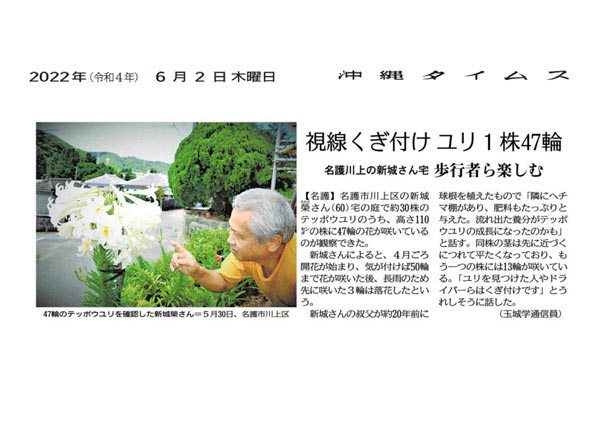
Sakae Shinjo who confirmed 47 Easter lilies in Kawakami-ku, Nago City, on May 30.
------------------------------
Eyes glued to a single lily plant with 47 blooms at Mr. Shinjo’s home in Nago
Passersby enjoy the blooms
Out of about 30 Easter lilies in the garden of Mr. Sakae Shinjo (60) in Kawakami-ku, Nago City, on one 110 cm tall Easter Lily 47 flowers were observed blooming. According to Mr. Shinjo, flowering began around April, and when he noticed, up to 50 flowers had bloomed, but then the three flowers that had bloomed earlier fell off due to the long rainy season.
Mr. Shinjo’s uncle planted the bulbs about twenty years ago. “There is a loofah trellis next to it, and I gave it plenty of fertilizer. The nutrients that flowed out may have led to the growth of the Easter lilies. The stem of this plant flattens as it nears the end, and another plant has 13 blooms. “The people and drivers who see the lilies were riveted by them,” he said happily.
(Reported by Manabu Tamashiro)

Sakae Shinjo who confirmed 47 Easter lilies in Kawakami-ku, Nago City, on May 30.
------------------------------
Okinawa Times, Sunday, December 28, 2014
An Astounding 10 kgs of Sweet Potatoes
Mr. Tsugumori Toma (70) of Matsuda-ku, Ginoza Village recently harvested sweet potatoes weighing 10kg from a single plant in his vegetable garden. He was delighted, saying, “This is the first time I have ever harvested such a large amount of sweet potatoes from a single plant.”
The sweet potatoes grew in his home garden, which measures about 33 square meters. Mr. Toma was proud of his sweet potatoes, saying, “Maybe it’s because I put in a lot of goat manure and other fertilizers.” His wife Yukie happily said, “I have never seen such large sweet potatoes. I think I will cook them tempura-style.”
Mr. Shunichi Gushiken, agricultural management advisor at the village’s Industrial Promotion Division, said, “I wonder if might be due to the good weather. When we grow sweet potatoes for home use, we put in plenty of fertilizer and carefully cultivate the plants, so we can sometimes harvest large sweet potatoes.”
(Reported by Akatsuki Nakachi)
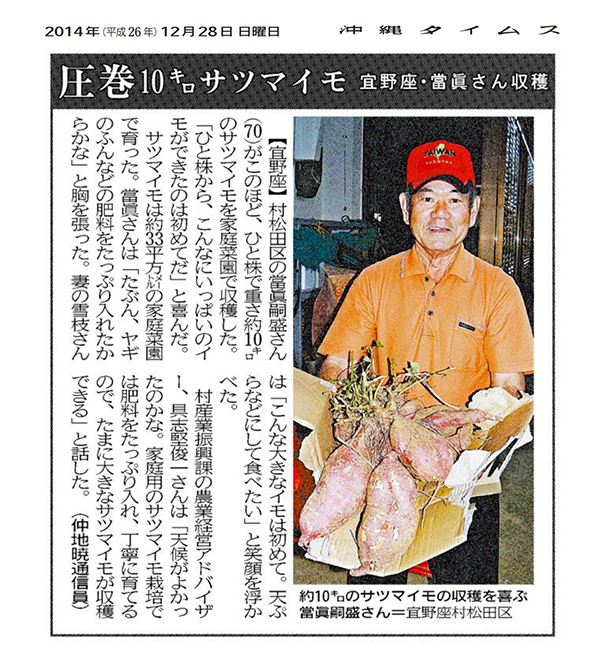
------------------------------
An Astounding 10 kgs of Sweet Potatoes
Harvested by Mr. Toma of Ginoza Village
Mr. Tsugumori Toma (70) of Matsuda-ku, Ginoza Village recently harvested sweet potatoes weighing 10kg from a single plant in his vegetable garden. He was delighted, saying, “This is the first time I have ever harvested such a large amount of sweet potatoes from a single plant.”
The sweet potatoes grew in his home garden, which measures about 33 square meters. Mr. Toma was proud of his sweet potatoes, saying, “Maybe it’s because I put in a lot of goat manure and other fertilizers.” His wife Yukie happily said, “I have never seen such large sweet potatoes. I think I will cook them tempura-style.”
Mr. Shunichi Gushiken, agricultural management advisor at the village’s Industrial Promotion Division, said, “I wonder if might be due to the good weather. When we grow sweet potatoes for home use, we put in plenty of fertilizer and carefully cultivate the plants, so we can sometimes harvest large sweet potatoes.”
(Reported by Akatsuki Nakachi)

------------------------------
Okinawa Times, Wednesday, May 25, 2022
The bright red flowers of the Royal Poinciana, an early summer flowering tree, have begun to bloom in various parts of Okinawa prefecture. On the 24th, when it continued to rain due to the rainy season front, passersby along Prefectural Road 33 in Toyohara, Uruma City, stopped to admire the large flowers, which had become wet and glossy in the rain.
According to the Okinawa Meteorological Observatory, there will be many rainy days over the next week, and there is a risk of heavy rain expected in the Sakishima Islands from the 25th to the 26th and in the main island area of Okinawa from the 26th to the 27th.
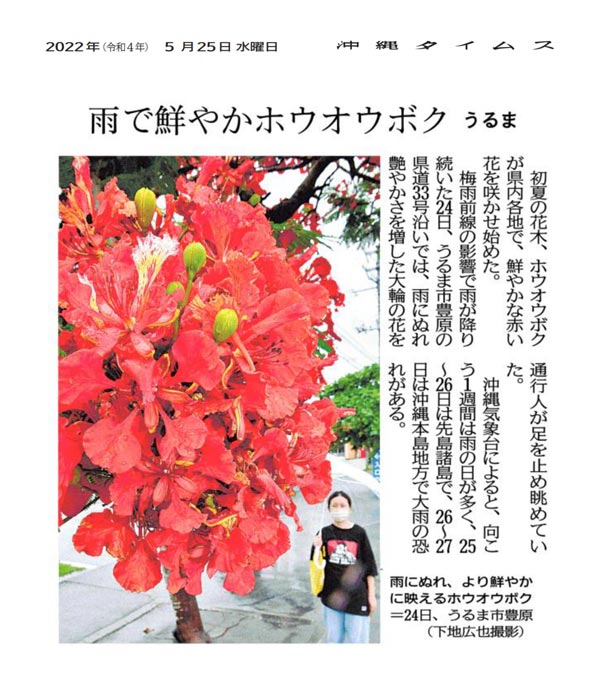
Wet Royal poinciana looks brighter and vivid in the rain, 24th, Toyohara, Uruma City
(Photo by Hiroya Shimoji)
------------------------------
Bright Royal Poinciana in the rain in Uruma City
The bright red flowers of the Royal Poinciana, an early summer flowering tree, have begun to bloom in various parts of Okinawa prefecture. On the 24th, when it continued to rain due to the rainy season front, passersby along Prefectural Road 33 in Toyohara, Uruma City, stopped to admire the large flowers, which had become wet and glossy in the rain.
According to the Okinawa Meteorological Observatory, there will be many rainy days over the next week, and there is a risk of heavy rain expected in the Sakishima Islands from the 25th to the 26th and in the main island area of Okinawa from the 26th to the 27th.

Wet Royal poinciana looks brighter and vivid in the rain, 24th, Toyohara, Uruma City
(Photo by Hiroya Shimoji)
------------------------------
If you give a lot of fertilizer to sweet potatoes, only the part above ground will grow and they will not become large potatoes, but after 2019, root vegetables have, year by year, become easier to grow, and larger potatoes and taro are now commonly harvested.
In Okinawa, it was said that it was absolutely impossible to grow potato seed potatoes due to the virus, but for several years now it has been possible to grow seed potatoes. In particular, the number of typhoons that hit Okinawa has decreased yearly since 2014, and this has impacted not only agricultural products but also the ecosystem of the entire island, which has become more stable. Power outages and lightning strikes have also decreased significantly.
In the past, I have described the effect of the Graviton barrier against typhoons and on the purification of the sea, Article 4 shows how this reality is happening.
This area was not fully reached by the Graviton barrier until 2017. As a result, a large-scale coral bleaching phenomenon occurred in 2017. As a countermeasure, in October 2018, we strengthened the barriers between Ishigaki and Iriomote Islands to the same level as the main island of Okinawa. Article 4 can be seen as proof of this.
From a conventional theoretical view, it was feared that the high temperatures in 2017 would cause coral bleaching throughout Okinawa, but in areas where the EM barriers are fully functioning there has been no damage at all, and large-scale coral spawning has been observed everywhere for the past several years.
Asahi Shimbun, March 26, 2021Coral in Ishigaki Island, Miraculously Revived
Video: Coral in Sakieda Bay, Ishigaki Island, Okinawa, Japan, taken by underwater photographer Kazushige Horiguchi.
On Ishigaki Island, Okinawa Prefecture, some of the coral reefs that were on the verge of extinction are showing signs of recovery. Kazushige Horiguchi, 34, an underwater photographer from Tokyo, captured the healthy growth of coral in late January. An expert stated that “The coral is extremely precious and it is important to maintain it in a healthy state, while many coral reefs are in danger of decline,” noting that the efforts to exterminate crown-of-thorns starfish that eat coral have been successful.
Mr. Horiguchi has been photographing coral for more than ten years in various locations in Japan. In most places, he says seaweed and coral have been reduced or the creatures that had been there before have disappeared.
Meanwhile he heard from a local guide that the coral in Sakieda Bay on Ishigaki Island had “miraculously recovered from a catastrophic situation. “I photographed the coral in Sakieda Bay for the first time in 2019. Since then, I have photographed the same area about ten times. When I dove in on January 20th, coral colonies were spread all over the area.” He said he had never seen such a wide area inhabited by table-shaped colonies of coral. “It was a powerful reminder of the power of life,” he added.
Last November, the United Nations Environment Program released a report stating that if we continue to rely on fossil fuels amid rising sea temperatures due to global warming, all coral reefs in the world’s oceans could be lost by the end of this century Regarding the situation in Japan the report states that “large-scale coral bleaching could become the norm in 2024.”
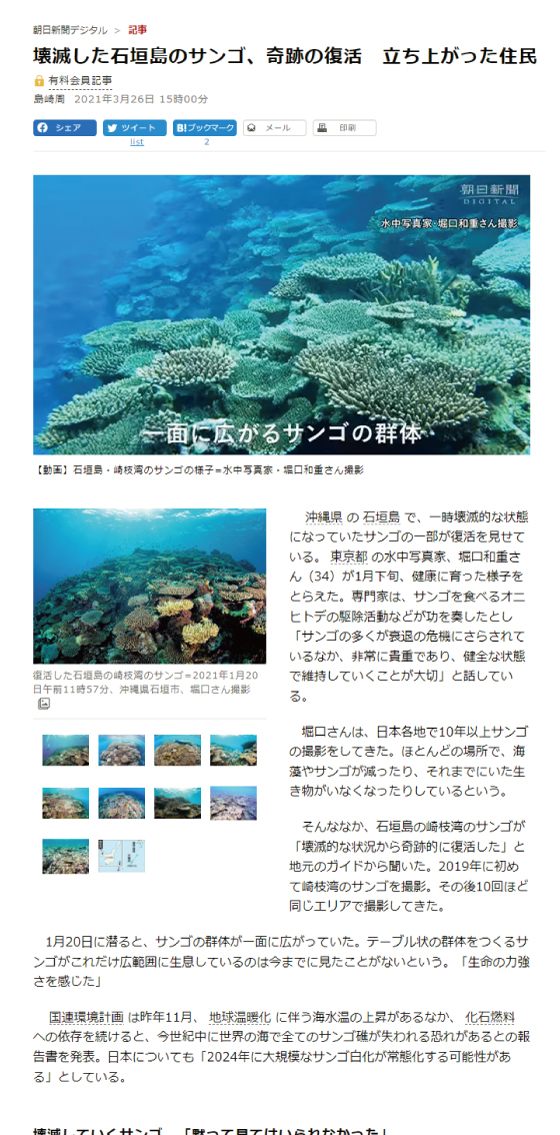
Prohibited to reprint without permission from Asahi Shimbun, Inc. Consent number: 22-1802
------------------------------
In Okinawa, it was said that it was absolutely impossible to grow potato seed potatoes due to the virus, but for several years now it has been possible to grow seed potatoes. In particular, the number of typhoons that hit Okinawa has decreased yearly since 2014, and this has impacted not only agricultural products but also the ecosystem of the entire island, which has become more stable. Power outages and lightning strikes have also decreased significantly.
In the past, I have described the effect of the Graviton barrier against typhoons and on the purification of the sea, Article 4 shows how this reality is happening.
This area was not fully reached by the Graviton barrier until 2017. As a result, a large-scale coral bleaching phenomenon occurred in 2017. As a countermeasure, in October 2018, we strengthened the barriers between Ishigaki and Iriomote Islands to the same level as the main island of Okinawa. Article 4 can be seen as proof of this.
From a conventional theoretical view, it was feared that the high temperatures in 2017 would cause coral bleaching throughout Okinawa, but in areas where the EM barriers are fully functioning there has been no damage at all, and large-scale coral spawning has been observed everywhere for the past several years.
Asahi Shimbun, March 26, 2021
Coral in Ishigaki Island, Miraculously Revived
Residents Taking a Stand
Coral colonies spread all over
Video: Coral in Sakieda Bay, Ishigaki Island, Okinawa, Japan, taken by underwater photographer Kazushige Horiguchi.
On Ishigaki Island, Okinawa Prefecture, some of the coral reefs that were on the verge of extinction are showing signs of recovery. Kazushige Horiguchi, 34, an underwater photographer from Tokyo, captured the healthy growth of coral in late January. An expert stated that “The coral is extremely precious and it is important to maintain it in a healthy state, while many coral reefs are in danger of decline,” noting that the efforts to exterminate crown-of-thorns starfish that eat coral have been successful.
Mr. Horiguchi has been photographing coral for more than ten years in various locations in Japan. In most places, he says seaweed and coral have been reduced or the creatures that had been there before have disappeared.
Meanwhile he heard from a local guide that the coral in Sakieda Bay on Ishigaki Island had “miraculously recovered from a catastrophic situation. “I photographed the coral in Sakieda Bay for the first time in 2019. Since then, I have photographed the same area about ten times. When I dove in on January 20th, coral colonies were spread all over the area.” He said he had never seen such a wide area inhabited by table-shaped colonies of coral. “It was a powerful reminder of the power of life,” he added.
Last November, the United Nations Environment Program released a report stating that if we continue to rely on fossil fuels amid rising sea temperatures due to global warming, all coral reefs in the world’s oceans could be lost by the end of this century Regarding the situation in Japan the report states that “large-scale coral bleaching could become the norm in 2024.”

Prohibited to reprint without permission from Asahi Shimbun, Inc. Consent number: 22-1802
------------------------------
The following, Articles 5 and 6, are just a few examples. As reported in the “Uchoten” section of the Okinawa Times, many large fish that once could only be caught by going offshore can now be caught from seawalls from 2014. Nowadays, you can catch fish not just in harbors, but everywhere.
Reference: List of articles on Uchoten, Okinawa Times + Plus
I thought that the last article was the end of reporting on birds, but here is additional information we have obtained.
Articles 7-11
Reference: List of articles on Uchoten, Okinawa Times + Plus
I thought that the last article was the end of reporting on birds, but here is additional information we have obtained.
Articles 7-11
Okinawa Times, Tuesday, May 24, 2022
The powerful workings of life
A summer tradition, the simultaneous spawning of corals, has begun off the coast of Yamato Village in Amami Oshima Island, Kagoshima Prefecture. Tiny capsules about 0.5 mm in diameter called “bundles” filled with sperms and eggs were released in large numbers during the night, turning the dark sea pink.
Mr. Katsuki Koh, 51, chairman of the Amami Marine Life Research Association, photographed the event at a depth of five meters off the national highway of Yamato Village, during the nights of March 20th to the 22nd. He was able to confirm the spawning of about ten different types of coral, and at the peak of the spawning season, he could hardly see anything in front of him. “I was impressed by the powerful coral activity.” Much of the coral in Amami Island has died due to crown of thorns starfish, feeding damage, and the bleaching phenomenon, but Chairman Koh said, “I hope that many larvae will be able to be established.”
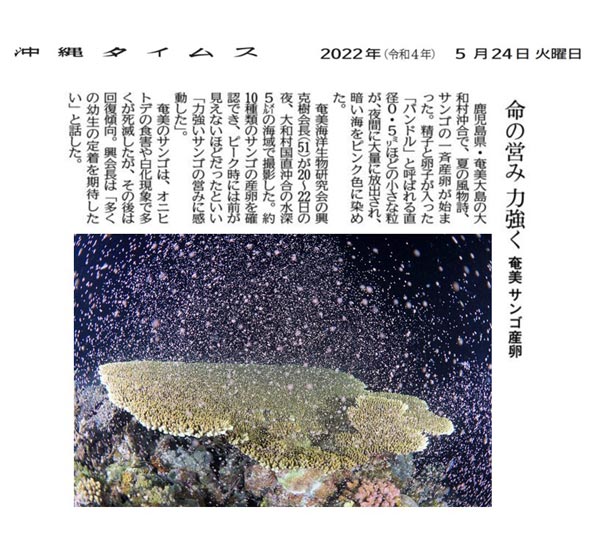
------------------------------
The powerful workings of life
Coral spawning in Amami
A summer tradition, the simultaneous spawning of corals, has begun off the coast of Yamato Village in Amami Oshima Island, Kagoshima Prefecture. Tiny capsules about 0.5 mm in diameter called “bundles” filled with sperms and eggs were released in large numbers during the night, turning the dark sea pink.
Mr. Katsuki Koh, 51, chairman of the Amami Marine Life Research Association, photographed the event at a depth of five meters off the national highway of Yamato Village, during the nights of March 20th to the 22nd. He was able to confirm the spawning of about ten different types of coral, and at the peak of the spawning season, he could hardly see anything in front of him. “I was impressed by the powerful coral activity.” Much of the coral in Amami Island has died due to crown of thorns starfish, feeding damage, and the bleaching phenomenon, but Chairman Koh said, “I hope that many larvae will be able to be established.”

------------------------------
Okinawa Times, Sunday, May 22, 2022
The pink color of the sea life of Ie Island
On the 20th, a large number of coral eggs were washed up on the beach at Ara and Gushi fishing port in Higashiemae, Ie village, and the beach was dyed pink. It is often seen in this season every year and has become an island tradition.
The area was filled with a distinctive smell, like a stronger scent of the sea. Mr. Yamaki, 41, who took the photo, said, “For two days before the drift my wife had been saying, ‘It smells like coral’ I was wondering if it would come soon,” he said.
Coral spawning takes place from May to June, around the night of the full moon and during high tides. This time, it appears a southerly wind blew it into shore. On the 21st, the wind changed direction and they had disappeared from the beach and the harbor. (Hinako Tamaki, Northern Press Department)
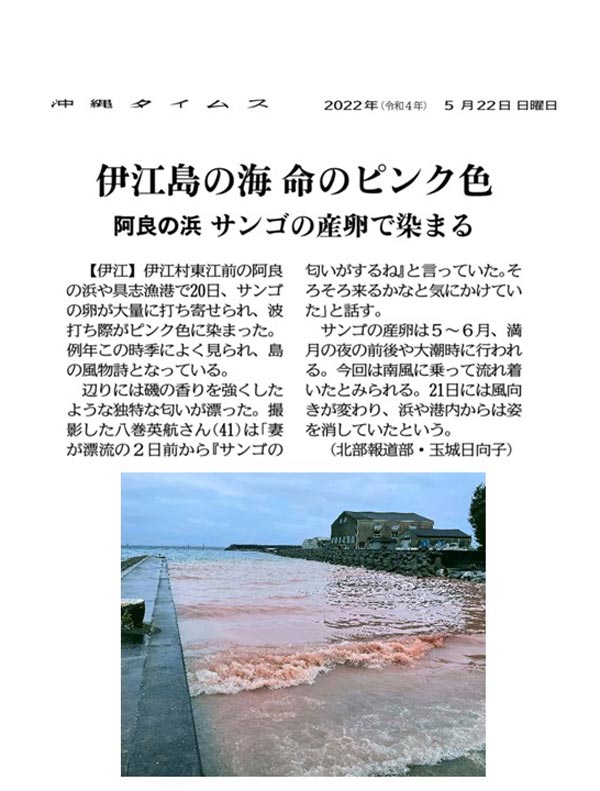
------------------------------
The pink color of the sea life of Ie Island
Ara beach dyed with coral spawning
On the 20th, a large number of coral eggs were washed up on the beach at Ara and Gushi fishing port in Higashiemae, Ie village, and the beach was dyed pink. It is often seen in this season every year and has become an island tradition.
The area was filled with a distinctive smell, like a stronger scent of the sea. Mr. Yamaki, 41, who took the photo, said, “For two days before the drift my wife had been saying, ‘It smells like coral’ I was wondering if it would come soon,” he said.
Coral spawning takes place from May to June, around the night of the full moon and during high tides. This time, it appears a southerly wind blew it into shore. On the 21st, the wind changed direction and they had disappeared from the beach and the harbor. (Hinako Tamaki, Northern Press Department)

------------------------------
Okinawa Times, Monday, May 23, 2022
Wild Birds Lively on Tarama Island
Thirteen black-faced spoonbills and more than 20 whiskered terns are resting in a reservoir in Tarama Village, which was drained to investigate a leak but which has standing water due to the long rainy season. One bird lover, Kunio Haneji, 73, took this photo on the 15th. Mr. Haneji said, “The birds were looking for food. I’m glad to see the birds so lively again.”
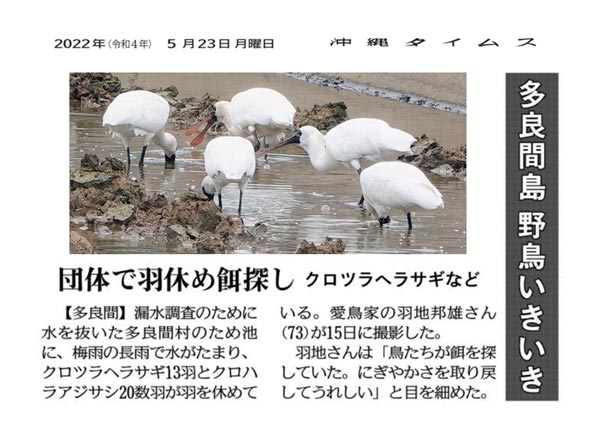
------------------------------
Wild Birds Lively on Tarama Island
Groups of birds resting and looking for food
Black-faced spoonbill and other birds
Thirteen black-faced spoonbills and more than 20 whiskered terns are resting in a reservoir in Tarama Village, which was drained to investigate a leak but which has standing water due to the long rainy season. One bird lover, Kunio Haneji, 73, took this photo on the 15th. Mr. Haneji said, “The birds were looking for food. I’m glad to see the birds so lively again.”

------------------------------
Okinawa Times, Monday, May 23, 2022
Tarama Island: Wild Birds Lively
A breeding pair of white-type herons has been confirmed on the coast of Tarama Village, Okinawa Prefecture. Bird lover, Kunio Haneji, 73, photographed the pair mating, incubating the eggs, and raising their young from March 6th to May 14th. Mr. Haneji also observed and photographed the mating-like breeding behavior of the female and male, who were incubating two eggs in the nest. He also captured the male and female taking turns incubating the eggs and returning to the nest with small fish to feed to the chicks.
Mr Haneji said, “The number of black-faced spoonbill is decreasing in Tarama. I took these pictures quietly from a distance so as not to disturb their breeding. The three chicks have safely left their nest now, so I decided to share these photos with the public.”
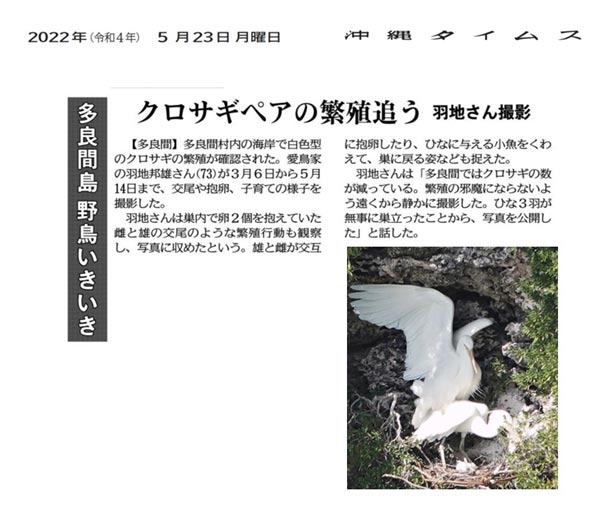
------------------------------
Tarama Island: Wild Birds Lively
Following a pair of breeding black-faced spoonbills
Photo by Mr. Haneji
A breeding pair of white-type herons has been confirmed on the coast of Tarama Village, Okinawa Prefecture. Bird lover, Kunio Haneji, 73, photographed the pair mating, incubating the eggs, and raising their young from March 6th to May 14th. Mr. Haneji also observed and photographed the mating-like breeding behavior of the female and male, who were incubating two eggs in the nest. He also captured the male and female taking turns incubating the eggs and returning to the nest with small fish to feed to the chicks.
Mr Haneji said, “The number of black-faced spoonbill is decreasing in Tarama. I took these pictures quietly from a distance so as not to disturb their breeding. The three chicks have safely left their nest now, so I decided to share these photos with the public.”

------------------------------
Okinawa Times, Thursday, May 26, 2022
The great Indian-almond Tree, Fuparushi
A Kwadisa (Indian Almond) tree, estimated to be 300-400 years old, is called “Fuparushi” in Imadomari -ku, Nakijin Village, Okinawa Prefecture. It seems that a Ryukyu Konohazuku (owl family) is raising its young in the Fuparushi tree. Ryukyu Konohazuku is a small owl, measuring only 20 cm in length. Its grayish-brown body has grayish-white or blackish spots that blend in with tree branches, making it difficult to spot. The local dialect name for the owl is “Chikkoho” in imitation of what its call sounds like.
Makoto Yonamine, head of Imadomari-ku, said, “They have been raising their young for a week now. There is a chick in the hollow of a Fuparushi tree. His big round eyes are so cute.”
(Reported by Manabu Tamaki)
An estimated 300 to 400 year-old Indian Armond tree in front of the community Center, on the 20th,at Imadomari, Nakijin Village
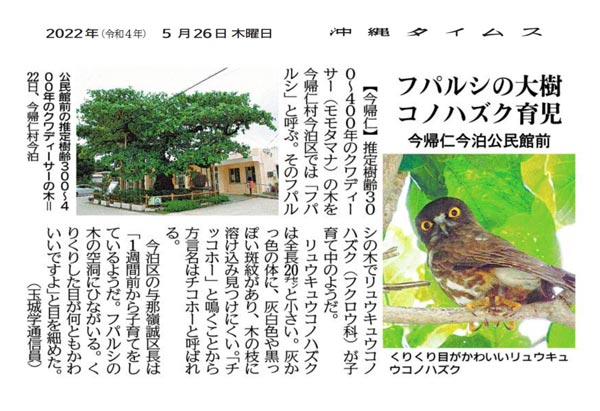
Ryukyu Konohazuku (owl)with cute round eyes, on the 22nd, at Imadomari, Nakijin Village
------------------------------
The great Indian-almond Tree, Fuparushi
Konohazuku, Eurasian Scops owl raising a chick in front of Imadomari Community Center, Nakijin Village
A Kwadisa (Indian Almond) tree, estimated to be 300-400 years old, is called “Fuparushi” in Imadomari -ku, Nakijin Village, Okinawa Prefecture. It seems that a Ryukyu Konohazuku (owl family) is raising its young in the Fuparushi tree. Ryukyu Konohazuku is a small owl, measuring only 20 cm in length. Its grayish-brown body has grayish-white or blackish spots that blend in with tree branches, making it difficult to spot. The local dialect name for the owl is “Chikkoho” in imitation of what its call sounds like.
Makoto Yonamine, head of Imadomari-ku, said, “They have been raising their young for a week now. There is a chick in the hollow of a Fuparushi tree. His big round eyes are so cute.”
(Reported by Manabu Tamaki)
An estimated 300 to 400 year-old Indian Armond tree in front of the community Center, on the 20th,at Imadomari, Nakijin Village

Ryukyu Konohazuku (owl)with cute round eyes, on the 22nd, at Imadomari, Nakijin Village
------------------------------
Okinawa Times, Tuesday, June 14, 2022
A Journeying Black-naped Oriole
On May 21, a migrating bird, the black-naped oriole, which is found from China to Southeast Asia and rarely flies to Japan during its migration, was observed in Shiokawa, Tarama Village, Okinawa Prefecture. Kunio Haneji, 74, a farmer, took this photo. The bird is about 25 cm in length, its entire body a bright yellow with black lines running from its eyes to the back of its head. Mr. Haneji was surprised when he found it. “It was perched on a pine tree branch,” he said. “I’d never seen this bird before. Its bright yellow color and pink beak are beautiful.”
(Daisuke Fukumoto, Editorial Writer)
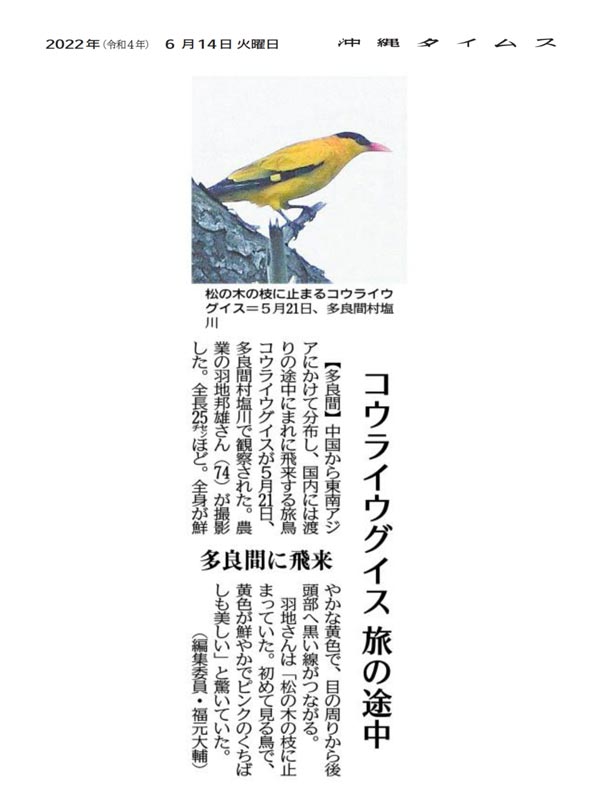
Black-naped oriole perching on a pine tree branch
May 21, in Shiokawa, Tarama Village
------------------------------
A Journeying Black-naped Oriole
Flew to Tarama
On May 21, a migrating bird, the black-naped oriole, which is found from China to Southeast Asia and rarely flies to Japan during its migration, was observed in Shiokawa, Tarama Village, Okinawa Prefecture. Kunio Haneji, 74, a farmer, took this photo. The bird is about 25 cm in length, its entire body a bright yellow with black lines running from its eyes to the back of its head. Mr. Haneji was surprised when he found it. “It was perched on a pine tree branch,” he said. “I’d never seen this bird before. Its bright yellow color and pink beak are beautiful.”
(Daisuke Fukumoto, Editorial Writer)

Black-naped oriole perching on a pine tree branch
May 21, in Shiokawa, Tarama Village
------------------------------
Okinawa Times, Thursday, June 16, 2022
A Rare Bird Resting in Ishigaki Island in the Rainy Season
The Asian koel cuckoo, which has been recorded as a rare stray bird in Japan, has recently flown to Ishigaki Island. Mr. Masahiro Kobayashi (47) of “Sea Beans,” a field guide service in Ishigaki Island, successfully photographed it over two consecutive years. The Oriental dollarbird and summer feather pheasant-tailed jacana, rarely seen in the prefecture, also made an appearance, making for a lively time during the rainy season.
According to Mr. Kobayashi, since early May he had heard the distinctive “koel, koel” call of the Asia koel and was able to confirm that it was indeed that bird when he spotted it perched on the tip of a tree branch on May 9th. An adult and fledglings were observed last August, and it is possible that the birds bred on the island. The bird is about 40cm long and in its Southeast Asian habitats is also called “the bird that announces the morning.”
On June 6th a dollarbird was also observed, perched on an electric wire. It has a red beak and legs, and from its size it appeared to be an adult. These birds are about 30 centimeters long and characteristically reuse nest woodpecker burrows to raise their young. The bird has been regarded as a sacred bird whose calls sounds like “Bupposo” (which means Buddhist monk), but in 1935 it was determined that this call is made by the Konohazuku, the scops owl. Konohazuku are now called the “vocal bupposo” and the dollarbird “the visual bupposo”.
On the 8th, a pheasant-tailed jacana with bright summer feathers was observed along with a black-winged stilt searching for food in a fallow field. On the 10th Mr. Kobayashi again spotted a second summer-winged pheasant-tailed jacana. This bird had a long tail, a white head, throat, and wings, and the back of its neck was yellow. These birds are usually found from Southeast Asia to southeastern Eurasia, and are rarely sighted in Japan because it is is not on their normal migratory course. There are even fewer observations of it with its summer plumage compared to its winter plumage. (Daisuke Fukumoto, Editorial Writer)
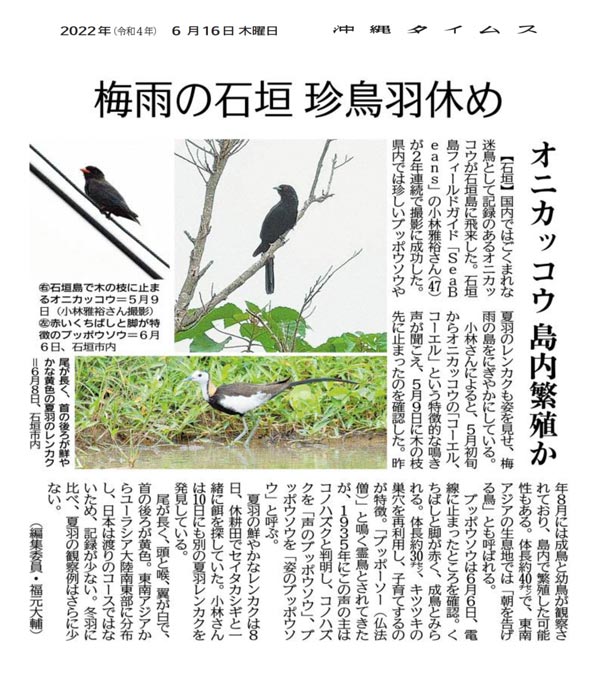
An Asian koel cuckoo perched on a tree branch on Ishigaki Island on May 9th (photo by Masaharu Kobayashi).
A Bupposo, characterized by its red beak and legs, in Ishigaki City on June 6th.
A Summer wren with a long tail and a bright yellow back of the neck, on June 8th in Ishigaki City.
(July 1, 2022)
A Rare Bird Resting in Ishigaki Island in the Rainy Season
Asian koel cuckoo: Breeding on the Island?
The Asian koel cuckoo, which has been recorded as a rare stray bird in Japan, has recently flown to Ishigaki Island. Mr. Masahiro Kobayashi (47) of “Sea Beans,” a field guide service in Ishigaki Island, successfully photographed it over two consecutive years. The Oriental dollarbird and summer feather pheasant-tailed jacana, rarely seen in the prefecture, also made an appearance, making for a lively time during the rainy season.
According to Mr. Kobayashi, since early May he had heard the distinctive “koel, koel” call of the Asia koel and was able to confirm that it was indeed that bird when he spotted it perched on the tip of a tree branch on May 9th. An adult and fledglings were observed last August, and it is possible that the birds bred on the island. The bird is about 40cm long and in its Southeast Asian habitats is also called “the bird that announces the morning.”
On June 6th a dollarbird was also observed, perched on an electric wire. It has a red beak and legs, and from its size it appeared to be an adult. These birds are about 30 centimeters long and characteristically reuse nest woodpecker burrows to raise their young. The bird has been regarded as a sacred bird whose calls sounds like “Bupposo” (which means Buddhist monk), but in 1935 it was determined that this call is made by the Konohazuku, the scops owl. Konohazuku are now called the “vocal bupposo” and the dollarbird “the visual bupposo”.
On the 8th, a pheasant-tailed jacana with bright summer feathers was observed along with a black-winged stilt searching for food in a fallow field. On the 10th Mr. Kobayashi again spotted a second summer-winged pheasant-tailed jacana. This bird had a long tail, a white head, throat, and wings, and the back of its neck was yellow. These birds are usually found from Southeast Asia to southeastern Eurasia, and are rarely sighted in Japan because it is is not on their normal migratory course. There are even fewer observations of it with its summer plumage compared to its winter plumage. (Daisuke Fukumoto, Editorial Writer)

An Asian koel cuckoo perched on a tree branch on Ishigaki Island on May 9th (photo by Masaharu Kobayashi).
A Bupposo, characterized by its red beak and legs, in Ishigaki City on June 6th.
A Summer wren with a long tail and a bright yellow back of the neck, on June 8th in Ishigaki City.
(July 1, 2022)
Editor’s Picks
-

#196 The Steadily Evolving EM Nature Farming Method at the Blue Sky Palace - Part 6 -

#195 The Steadily Evolving EM Nature Farming Method at the Blue Sky Palace - Part 5 -

#191 Steadily Evolving EM Nature Farming Method at the Blue Sky Palace -

#190 Quantum Mechanical Effects of EM Gravitron Charcoal
- 2025
- Apr:#204 How EM Use Has Spread Throughout the Philippines
- Mar:#203 How to Use EM to Fundamentally Solve the Problem of Agricultural Residue Burning
- Feb:#202 The Spread of EM technology in Germany
- Jan:#201 The 2nd Ichiro Masaki Memorial Universal Village EM International Conference
- Jan:#200 Cleanup of the Ala Wai Canal in Hawaii, where social bonds are strengthened using EM
- 2024
- Nov:#199 EM trials in India with bananas, tomatoes, and pomegranates
- Oct:#198 The Steadily Evolving EM Nature Farming Method at the Blue Sky Palace - Part 8
- Sep:#197 The Steadily Evolving EM Nature Farming Method at the Blue Sky Palace - Part 7
- Aug:#196 The Steadily Evolving EM Nature Farming Method at the Blue Sky Palace - Part 6
- Jul:#195 The Steadily Evolving EM Nature Farming Method at the Blue Sky Palace - Part 5
- Jun:#194 Steadily Evolving EM Nature Farming Method at the Blue Sky Palace - Part 4
- May:#193 Steadily Evolving EM Nature Farming Method at the Blue Sky Palace - Part 3
- May:#192 Steadily Evolving EM Nature Farming Method at the Blue Sky Palace - Part 2
- Apr:#191 Steadily Evolving EM Nature Farming Method at the Blue Sky Palace
- Mar:#190 Quantum Mechanical Effects of EM Gravitron Charcoal
- Mar:#189 The barrier space in Okinawa (Ryukyu Islands) has risen to another dimension
- Jan:#188 Sixty Days after Typhoon No.6
- 2023
- Oct:#187 Supermassive Typhoon No.6 and Subsequent Typhoon No. 11
- Sep:#186 Massive Typhoon No.6 that swallowed the Ryukyu Islands Graviton barrier
- Sep:#185 August 8th is World “EM Mudball Day”
- Aug:#184 A disease-free life depends on the health of the intestinal microbiome.
- Jul:#183 Trial and Error at the Blue-Sky Palace, Part 3
- Jun:#182 Trial and Error at the Blue-Sky Palace, Part 2
- Apr:#181 Trial and Error at the Blue-Sky Palace
- Mar:#180 Ala Wai Canal Cleanup Project in Waikiki, Hawaii
- Feb:#179 High-Yield, High-Quality Rice Production Using EM
- Feb:#178 The Progress the "Soil Preparation Workshop" of the Oishi 3-chan Club (Part 2)
- Jan:#177 Organic Farming Instructional Manual Using EM
- 2022
- Nov:#176 The Typhoon Situation in Okinawa in 2022
- Sep:#175 Third-Party Verification of the Graviton barrier in Okinawa Part-2
- Sep:#174 Third-Party Verification of the Graviton barrier in Okinawa
- Aug:#173 Ecosystem Changes Observed in Okinawa in 2021 Part-5
- Jun:#172 Ecosystem Changes Observed in Okinawa in 2021 Part-4
- May:#171 Ecosystem Changes Observed in Okinawa in 2021 Part-3
- Apr:#170 Ecosystem Changes Observed in Okinawa in 2021 Part-2
- Mar:#169 Koizumi Farm in Kamakura Continues to Evolve
- Feb:#168 Ecosystem Changes Observed in Okinawa in 2021 Part-1
- 2021
- Dec:#167 Enjoying EM Technology While Enriching the Local Ecosystem
- Nov:#166 A Case Study of the Use of EM in a Next Generation Free School in Tune with the Cycles of Nature
- Oct:#165 Typhoon conditions and flowers in Okinawa from August to October
- Sep:#164 Re-learning the origins of river purification using EM Cleaning up the Dairyuji River in Senami (Murakami City, Niigata Prefecture)
- Aug:#163 Measures Against Natural Disasters and Re-learning the Starting Point of EM
- Jul:#162 Summary of FFC (Foods for Children) Okinawa Forum 2021
- Jun:#161 Restoring the Vigor of an Old Tree and Purifying the Environment with EM Technology That Even an Amateur Can Do
- May:#160 The Public is Beginning to Recognize the Use of EM Smokeless Carbonizers
- Apr:#159 EM Hado (EM Graviton) that exerts quantum superposition effect over time
- Mar:#158 Virus-free Okinawan Plants Through Use of an EM Graviton Barrier
- Jan:#157 Enjoyable Farming for Self-Sufficiency that Even Amateurs Can Do
- 2020
- Dec:#156 EM quantum energy effect occurring in Okinawa
- Nov:#155 Implementing EM graviton farming as a flood countermeasure for apple orchards
- Oct:#154 The Latest Book on the Practical Uses of EM "You Are the One Who Draws Out the Power of Microorganisms," by Chizuko Nomoto
- Sep:#153 Application of EM technology to long periods of rain, lack of sunshine, storms, heavy rains, etc.
- Aug:#152 EM application in Kitanakagusuku village plant waste recycling yard
- Jul:#151 Natural Disaster Countermeasures Using EM Technology: Part 2
- Jul:#150 Natural Disaster Countermeasures Using EM Technology
- May:#149 How to make your home and workplace an energy spot by living a complete EM lifestyle: creating the ultimate source of health and environmental purification
- Apr:#148 EM, Viruses and the Pandemic
- Apr:#147 New agriculture applying quantum mechanics Part 2
- Apr:#146 New agriculture applying quantum mechanics
- Apr:#145 Wonderful EM Miracle
- 2019
- Nov:#144 The movie “Revival II” and the reality of Fukushima
- Oct:#143 Boundary dome and foliar spraying of EM・X GOLD and EM 3
- Oct:#142 Kirakira (Sparkling) Summer Vegetable Festa in 2019
- Aug:#141 Excessive salt inevitably causes salt damage
- Jul:#140 Diverse applications of charcoal Part 3
- Jun:#139 Diverse applications of charcoal Part 2
- Jun:#138 Diverse applications of charcoal
- Jun:#137 Purification power of salt
- May:#136 The degree of soil contamination is a reflection of the microflora
- May:#135 Definitive use of EM barriers to deal with typhoons
- May:#134 Implementing authentic Nature Farming
- May:#133 How to enhance healthy Hado (wave energy) by EM
- May:#132 Eating Dirt (Soil)
- May:#131 Hado (Wave energy) involved in health
- May:#130 Reaffirming EM technology to realize the essence of agriculture
- May:#129 The 2nd EM Producer Networking Meeting
- Apr:#128 Understanding the application of seawater and salt in crop cultivation
- Apr:#127 Prevention of Disasters by EM Technology
- Mar:#126 Quantum overlay effective utilization of EM
- Jan:#125 EM Disaster Recovery Support Projects in 2017
- 2018
- 2017
- Aug:#121 Escape from conventional agricultural traps
- Jul:#120 Limitation and important caveats regarding utilization of salt
- Jun:#119 EM Technology to Break Through the Limits of Pesticide-Free Strawberries
- May:#118 Application of barriers using EM rectification force
- Apr:#117 The 1st EM Produce Growers' Networking Conference
- Mar:#116 Sumizo kun: The Ultimate Versatile Carbonization Equipment
- Feb:#115 How to make and use simple carbonized and rectified ash
- Jan:#114 Achievements of 2016
- 2016
- Dec:#113 Definitive Measures Against Typhoons
- Nov:#112 International Conference on Universal Village
- Oct:#111 90% of Your Body is Microbes
- Sep:#110 Disaster Countermeasures Using EM
- Aug:#109: Changes in the Natural Environment by EM Barrier Domes in Okinawa
- Jul:#108: Multi-purpose Utilization of Activated EM with Seawater and Salt
- Jun:#107: Marine Day, when EM Mudballs and Activated EM are Applied Throughout Japan
- May:#106: The Function of EM and Gravitational Waves–Part 3
- Apr:#105: The Function of EM and Gravitational Waves–Part 2
- Feb:#104: The Function of EM and Gravitational Waves
- Feb:#103: The Importance of Phototrophic Bacteria in EM
- 2015
- Dec:#102: Results of Environmental Forum "Utsukushima EM Paradise" 2015
- Nov:#101: Environmental Forum "Utsukushima EM Paradise" 2015
- Oct:#100: A New Phase of Limit Breakthrough Using EM
- Sep:#99: A New Phase of Limit Breakthrough through EM
- Aug:#98: The Tokyo Bay Area Began Creating a Truly Livable Hometown
- Jul:#97: Rectifying Effects of EM
- Jun:#96: Lake Suwa Sousei lecture
- May:#95: In Order to Further Ensure Limit Breakthrough
- Apr:#94: Theatrical Release of the Documentary Film SOSEI-Revival to Enlighten People on the New Possibilities of Microorganisms
- Mar:#93: What Underlies Limit Breakthrough (Part 2)
- Feb:#92: EM Functions to Break Through Limits
- Jan:#91: At the Start of 2015
- 2014
- Dec:#90: Looking Back at 2014
- Nov:#89: Shikoku EM FESTA 2014, Virtuous Circle Conference in Matsuyama, Ehime Prefecture
- Oct:#88: Using EM to Deal with Weather Disasters (Part 2)
- Sep:#87: Current Status of Radioactivity Measures Using EM in Fukushima
- Aug:#86: APNAN (Asia Pacific Natural Agriculture Network) 25th Anniversary Conference in 2014
- Jul:#85: Using EM to Deal with Weather Disasters
- Jun:#84: Substantial Improvement of Soil
- May:#83: The Energy Rectification Force of EM
- Apr:#82: The Annual 18th EM Technology Exchange Meeting and Tohoku Conference in Shichigahama
- Mar:#81: Salmon going upstream in Kitaura (Kasumigaura)
- Feb:#80: The Microbiome Again
- Jan:#79: Inauguration of the Federation of Diet Members Who Use and Apply Effective Microorganisms
- 2013
- Dec:#78: Receiving an Honorary Doctoral Degree from Rajamangala University of Technology in Thailand
- Nov:#77: The Use of EM in School Education in Bhutan
- Oct:#76: Well of Bonding
- Sep:#75: The Background to EM Not Being Employed by Public Institutions to Deal with Radiation
- Aug:#74: Dealing with Disaster: Using EM in Crisis Management
- Jul:#73: EM Events on Ocean Day
- Jun:#72: Using EM to Deal With Heat Stroke and Summer Heat Fatigue
- May:#71: An EM Model Town in Malaysia
- Apr:#70: Steps the Japanese Government is Taking to Deal with Radiation: Are They Really Safe?
- Mar:#69: EM Group Disaster Reconstruction Aid Project in Fukushima
- Feb:#68: EM and Microbiomes (Microbial Flora)
- Jan:#67: A Necessary Evil is Still Evil
- 2012
- Dec:#66: The 17th National EM Technology Exchange Conference / Hokkaido Conference in Sapporo
- Nov:#65: EM Forum 2012 in Okinawa and the Environmental Forum in Fukushima
- Oct:#64: 2012 EM Forum
- Sep:#63: A New Earth Saving Revolution
- Aug:#62: The Asahi Newspaper’s Misguided Reports About EM
- Jul:#61: Using EM in Radioactive Contamination Measures in Fukushima Prefecture
- Jun:#60: The Effects of Using EM to Inhibit the Absorption of Radioactivity as Confirmed in Fukushima
- May:#59: Recovery Support for the Great East Japan Earthquake
- Apr:#58: The Royal Kingdom of Thailand, in which EM Functions as a Set Government Policy
- Mar:#57: Report on the Measures Taken by Kingdom of Thailand Using EM to Deal with Polluted Water
- Feb:#56 EM™ as Part of National Policy in Thailand to Deal with Sanitation Issues Resulting from the Flood of 2011
- Jan:#55 The Law of Syntropy (Revitalization)
- 2011
- Dec:#54 EM Forum 2011
- Nov:#53 Shikoku EM Festa 2011- Zenjunkan no Wa (Virtuous Circle) Tokushima Conference in Naruto -
- Oct:#52 The Mystery of Interim Safety Values for Radioactive Material
- Sep:#51 Successful Radiation Countermeasures Using EM
- Aug:#50 Events on Sea Day in which EM Mud Balls are Thrown into the Water and Activated EM is Applied.
- May:#47 Dealing with the Damage Caused by the Eastern Japan Earthquake
- Apr:#46 Eastern Japan Earthquake
- Mar:#45 The 16th National EM Technology Hokuriku Conference in Fukui
- Feb:#44 More Thoughts on Avian Influenza and Foot-and-Mouth Disease
- Jan:#43 Happy New Year!
- 2010
- Dec:#42 Shikoku EM FESTA 2010・Zenjunkan no wa (Virtuous Circle) Fellowship Conference in Tobe, Ehime Prefecture
- Nov:#41 EM Forum 2010
- Oct:#40: My Thanks to the EM™ Volunteers Who Helped in the Fight Against Foot-and-Mouth Disease in Miyazaki Prefecture
- Sep:#39 International EM Mud Ball Day
- Jul:#37 Poland EM Forum 2010
- Jun:#36 EM Countermeasures Against Foot-and-Mouth Disease
- May:#35 Abnormal Weather
- Apr:#34 EM Activities in Thailand: Finding Solutions to the Challenges Facing the Nation
- Mar:#33 New Developments in the Evolution of EMTM in Thailand
- Feb:#32 Results Starting to Be Seen at the Mikasa Project
- Jan:#31 Towards an EM-Use Society
- 2009
- Dec:#30 EM Summit
- Nov:#29 The System in Penang State in Malaysia that Made the World EMTM Mudball Day a Success
- Oct:#28 The "World EM Mudball Day" in Malaysia
- Sep:#27 Validating EMTM Medicine: Case Study Reports from EM Users 2009. (Part 3)
- Sep:#26 Validating EMTM Medicine: Case Study Reports from EMTM Users 2009. (Part 2)
- Jul:#25 Validating EMTM Medicine: Case Study Reports from EMTM Users 2009. (Part 1)
- Jun:#24 Activities to Disseminate EM-Focused Nature Farming in China
- May:#23 Use of EMTM in Response to Swine Flu
- Apr:#22 Using EM to Solve Public Administrative Costs
- Mar:#21 Reaffirming the Versatility of EM
- Jan:#20 The Beginning of a New Era
- 2008
